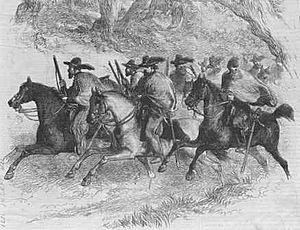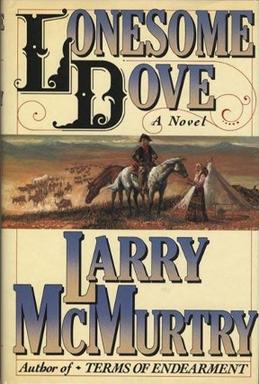
Lonesome Dove is a 1985 Western novel by American writer Larry McMurtry. It is the first published book of the Lonesome Dove series and the third installment in the series chronologically. It was a bestseller and won the 1986 Pulitzer Prize for Fiction. In 1989, it was adapted as a TV miniseries starring Tommy Lee Jones and Robert Duvall, which won both critical and popular acclaim. McMurtry went on to write a sequel, Streets of Laredo (1993), and two prequels, Dead Man's Walk (1995) and Comanche Moon (1997), all of which were also adapted as TV series.

King Ranch is the largest ranch in the United States. At some 825,000 acres it is larger than both the land area of Rhode Island and the area of the European country Luxembourg. It is mainly a cattle ranch, but also produced the racehorse Assault, who won the Triple Crown in 1946.

South Texas is a geographic and cultural region of the U.S. state of Texas that lies roughly south of—and includes—San Antonio. The southern and western boundary is the Rio Grande, and to the east it is the Gulf of Mexico. The population of this region is about 4.96 million according to the 2017 census estimates. The southern portion of this region is often referred to as the Rio Grande Valley. The eastern portion along the Gulf of Mexico is also referred to as the Coastal Bend.
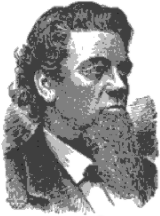
Richard King was a riverboat captain, Confederate, entrepreneur, and most notably, the founder of the King Ranch in South Texas, which at the time of his death in 1885 encompassed over 825,000 acres (3,340 km2).

Juan Nepomuceno Cortina Goseacochea, also known by his nicknames Cheno Cortina, the Red Robber of the Rio Grande and the Rio Grande Robin Hood, was a Mexican rancher, politician, military leader, outlaw and folk hero. He was an important caudillo, military general and regional leader, who effectively controlled the Mexican state of Tamaulipas as governor. In borderlands history he is known for leading a paramilitary mounted Mexican Militia in the failed Cortina Wars. The "Wars" were raids targeting Anglo-American civilians whose settlement Cortina opposed near the several leagues of land granted to his wealthy family on both sides of the Rio Grande. Anglo families began immigrating to the Lower Rio Grande Valley after the Mexican Army was defeated by the Anglo-Mexican rebels of the Mexican State of Tejas, in the Texas Revolution.

The Cortina Troubles is the generic name for the First Cortina War, from 1859 to 1860, and the Second Cortina War, in 1861, in which paramilitary forces led by the Mexican rancher and local leader Juan Cortina, confronted elements of the United States Army, the Confederate States Army, the Texas Rangers, and the local militias of Brownsville, Texas, and Matamoros, Tamaulipas.

John Salmon Ford, better known as "Rip" Ford, was a member of the Republic of Texas Congress and the Texas Senate. He was also the mayor of Brownsville and Austin. Ford was a Texas Ranger, a Confederate colonel, a doctor, a lawyer, and a journalist and newspaper owner. He commanded men during the Antelope Hills expedition and later led the Confederate forces in what was arguably the last engagement of the American Civil War, the Battle of Palmito Ranch on May 12–13, 1865. It was a Confederate victory, but as it occurred more than a month after Robert E. Lee's surrender, it did not affect the war's outcome.

Leander Harvey McNelly was a Confederate officer and Texas Ranger captain. McNelly is best remembered for leading the "Special Force", a quasi-military branch of the Texas Rangers that operated in south Texas in 1875–76.
Blas María de la Garza Falcón de Villarreal was a Spanish settler of Tamaulipas and South Texas.
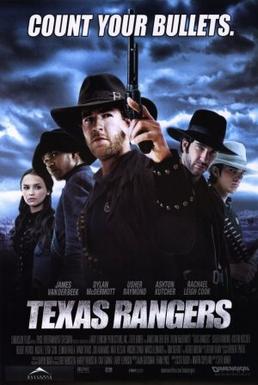
Texas Rangers is a 2001 American action Western film directed by Steve Miner and starring James Van Der Beek, Ashton Kutcher, Alfred Molina, and Dylan McDermott. It follows a group of Texas Rangers in the post-American Civil War era. The film is very loosely based upon the book Taming the Nueces Strip by George Durham, who based it on his own experiences serving in Captain Leander McNelly's Texas Ranger group as a young man. The film was panned by critics and was a box office bomb.
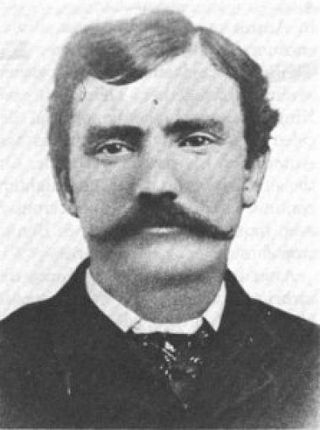
John King Fisher was a gunslinger from the U.S. state of Texas during the heyday of the American Old West.

Juan Alamia was an American soldier who served as a Rough Rider in the Spanish–American War.
The origins of today's Texas Ranger Division trace back to the first days of Anglo-American settlement of what is today the State of Texas, when it was part of the Province of Coahuila y Tejas belonging to the newly independent country of Mexico. The unique characteristics that the Rangers adopted during the force's formative years and that give the division its heritage today—characteristics for which the Texas Rangers would become world-renowned—have been accounted for by the nature of the Rangers' duties, which was to protect a thinly populated frontier against protracted hostilities, first with Plains Natives tribes, and after the Texas Revolution, hostilities with Mexico.

The Battleground Gunfight, also known as the Battleground Shootout, was a gunfight between a posse of American lawmen and the Smith Gang. It was fought on October 8, 1901, within Arizona Territory's Fort Apache Indian Reservation, at a clearing in the forest known today as the "Battleground". Nine Arizona Rangers and deputies caught up with the cattle rustler Bill Smith and his gang. During a long exchange of gunfire that followed, Ranger Carlos Tafolla and Deputy Bill Maxwell were killed and one or two of the outlaws may have been wounded. In the end, the Smith Gang escaped the posse and fled into Mexico.
The Bandit War, or Bandit Wars, was a series of raids in Texas that started in 1915 and finally culminated in 1919. They were carried out by Mexican rebels from the states of Tamaulipas, Coahuila, and Chihuahua. Prior to 1914, the Carrancistas had been responsible for most attacks along the border, but in January 1915, rebels known as Seditionistas drafted the Plan of San Diego and began launching their own raids. The plan called for a race war to rid the American border states of their Anglo-American population and for the annexation of the border states to Mexico. However, the Seditionistas could never launch a full-scale invasion of the United States and so the faction resorted to conducting small raids into Texas. Much of the fighting involved the Texas Ranger Division, but the US Army also engaged in small unit actions with bands of Seditionist raiders.

The Battle of La Ebonal was fought in December 1859 near Brownsville, Texas during the First Cortina War. Following the Brownsville Raid, on September 28, and a few skirmishes with the Texas Rangers, rebel leader Juan Cortina led his small army into the hills outside of town and dug in near a series of cattle ranches. The United States Army responded by sending an expedition into the area, under the command of Major Samuel P. Heintzelman, with orders to pacify all resistance. A minor battle began on December 13, at a ranch called La Ebonal, and continued for a few hours as the Americans routed and then pursued the retreating Cortinistas.

The Battle of Tres Jacales was an Old West gunfight that occurred on June 30, 1893. While out searching for a gang of rustlers, a group of American lawmen under the command of the Texas Ranger Frank Jones were attacked at the Mexican village of Tres Jacales. During the exchange of gunfire, Jones was mortally wounded and the remaining Americans were forced to retreat back into Texas.
Adrián J. Vidal was a Mexican soldier who fought in both the American Civil War and the Mexican War against France in the 1860s. He served the Confederate States of America Army from October 1862 to 1863, when he and his troops defected. He was branded a traitor, having killed one Confederate soldier, wounded another, and killed as many as ten or more individuals. He was said to have planned an attack on Brownsville after defecting from the Confederate Army. In the end, General Hamilton P. Bee ordered that Fort Brown and Brownsville be set on fire, destroying large quantities of cotton and military goods under the watchful eyes of 400 Union troops as well as Juan Cortina and his soldiers on the opposite bank of the Rio Grande. The next month, he enlisted in the Union Army, serving just six months. During that time he captured an Army tugboat and its crew. He then fought under General Juan Cortina during the Second French intervention in Mexico. Vidal was captured by the French who executed him by a firing squad in June 1865.

Mifflin Kenedy (1818–1895) was a rancher, steamboat operator, and investor who settled in Texas. He began his steamboating career on the Ohio, Mississippi, and Missouri Rivers. He then went to Texas and northern Mexico, where he helped get many steamboats to the Rio Grande area during the First Cortina War (1859–1860). Using the Corvette, he transported General Zachary Taylor and his soldiers on the Rio Grande and then overland to Camargo, Mexico. He became successful during the Civil War when he transported goods along the Rio Grande. Kenedy operated ranches and invested in railroads in Texas, some of them in partnership with Richard King. He was among the first ranchers to fence in his ranches, starting with the 36-miles of fencing around Laureles Ranch. Kenedy was inducted into the Hall of Great Westerners.

The Brownsville Raid was the opening act of the Cortina Troubles, a series of raids by Mexican rancher Juan Cortina into Texas. The raid was precipitated by Brownsville sheriff Robert Shears attacking a Mexican man named Thomas Cabrera and in turn being shot by Cortina. The incident was a culmination of growing discontent between Mexicans and Texan settlers.
